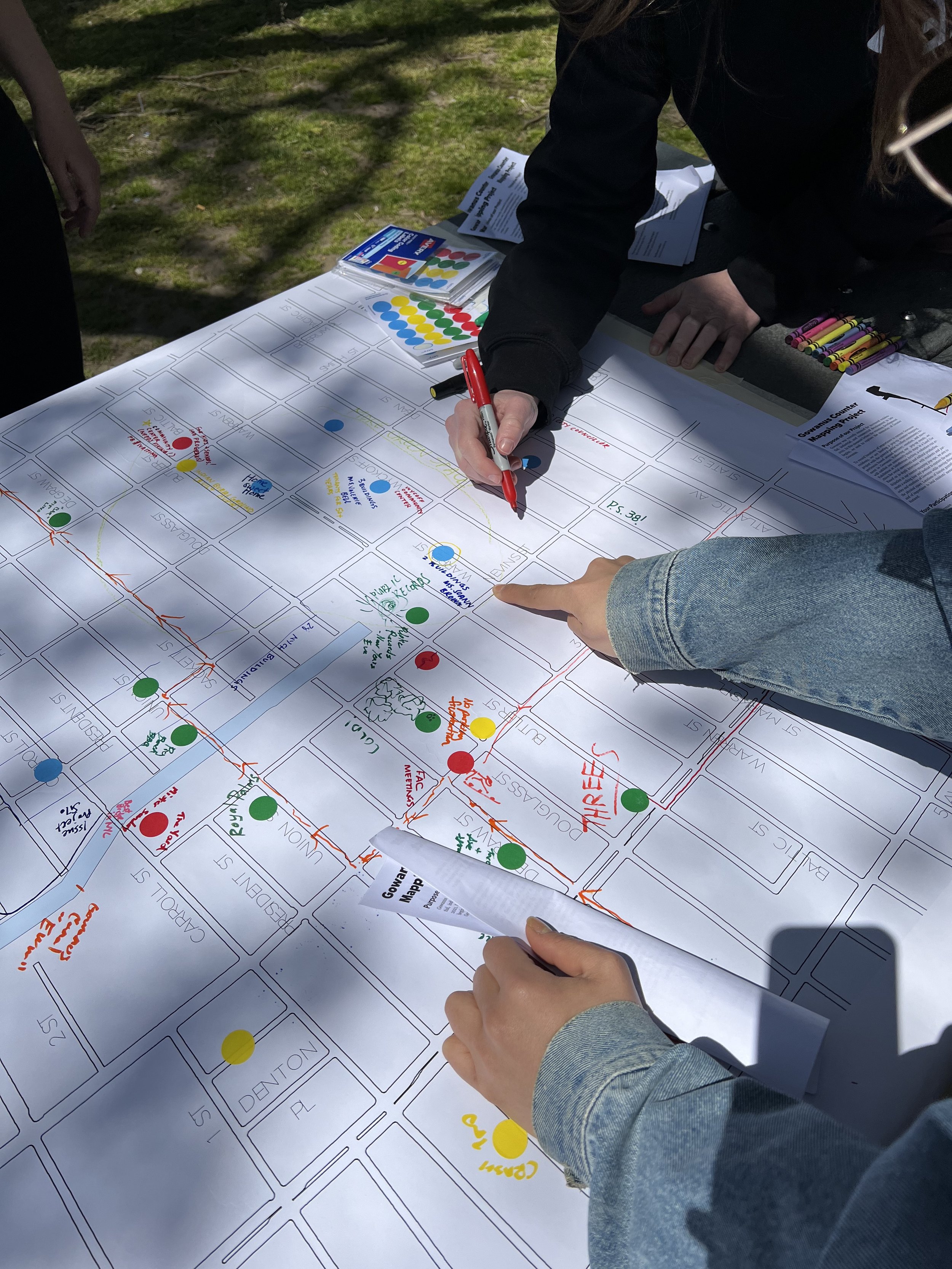Critical Cartography: Capturing Collective Memory in Gowanus, Brooklyn
January - May 2022
The Gowanus Neighborhood Plan, an 82-block redevelopment project in Gowanus, Brooklyn, was passed in late November 2021 after over a decade of conflict, community collaboration, and reports. This plan permits increased residential, industrial, and commercial development for the region. Since the Gowanus Neighborhood Plan was passed in late 2021, Gowanus is a site of forthcoming development. However, most of this development has not yet taken place.
As a team of four, the Gowanus Counter-Mapping Project observed the current needs of Gowanus. Based on our observations of Gowanus through public space, housing, mobility, and small businesses, we uncovered the need for preserving the memory of Gowanus’ past. Past residents are often erased due to the area being claimed as primarily industrial.
We identified many areas of intervention for future work, centered around the concept of capturing the collective memory of place and archiving the experiences of Gowanus residents. We want to challenge the dominant conceptualization of Gowanus and provide a particularism of the space that is not often explored.
Project Outline & Design Strategy
In this moment before the rezoning development begins, we seek to capture the memories of Greater Gowanus. To record locations of importance to current Gowanus residents, we hosted a pop-up counter-mapping project with the general public to collect community experiences based around memory, emotion, and movement in Gowanus.
Based on in-depth interviews with residents and participation in our counter-mapping pop-ups, we aim to create a walking tour and podcast to capture the memories and emotions of Gowanus while moving through the physical space.
To record locations of importance to current Gowanus residents, we hosted pop-up counter-mapping project events with community partner, Interference Archive, a volunteer-run archive for social movements and cultural production.
We asked folks to note locations based around their memory, movement, emotion, and home in Gowanus. We posed the following questions as inspiration:
How does Gowanus make you feel?
What emotions are tied to Gowanus?
What are sites of importance in your memory of Gowanus?
What sites are worth celebrating? What sites are worth fighting for?
What places are changing/vanishing?
How do you remember Gowanus?
What’s your first memory of Gowanus?
How do you move through Gowanus?
What physical spaces do you inhabit?
When did you move to Gowanus? From where?
Where in Gowanus is home to you?
POP UP EVENT, 4/10
On April 10, 2022, we hosted a pop-up event from 12 pm - 4 pm at Thomas Greene Playground. We brought our own table, and a 40 x 60 inch map of the Gowanus area. We taped the Gowanus map to a picnic table in the middle of Thomas Greene. To interact with the map, we provided stickers and markers. We asked visitors to “Map your Gowanus! What does Gowanus mean to you?” in four general themes: emotion, memory, movement, and home. We purposefully left these categories and questions vague to see the kinds of experiences and stories that people organically told.
We interacted with approximately 15-20 Gowanus residents during our event and received the contact information of a handful of people who expressed an interest in participating in an in-depth interview with us. We received stories and memories of past and present Gowanus.
Unfortunately, the weather was not ideal for our event and we experienced low turnout. Due to the wind and cold, it was difficult to catch passersby and ask them to stay to participate in our event. We decided to host a second event at the same time as a children’s skateboarding event in the park, Gowanus Grind.
POP UP EVENT, 4/30
In order to engage the community further, we hosted a second pop-up event on 4/30 at Thomas Greene. We chose this time and place because it coincides with Gowanus Grind, a skateboarding event for children in the neighborhood. They had activities from 11 am to 4 pm in Thomas Greene Skatepark. Because many children will be too young to attend alone, we used the captive audience of their parents.
Our second pop-up event was a resounding success. Approximately 100 people came for Gowanus Grind and many stopped by our map table. The warm and sunny weather and the event clientele helped us to maintain a captive audience for hours. Gowanus Grind was hosted in collaboration with the Brooklyn School of Music, so many student musicians performed while we were in the park. The musical back drop created an elevated mood which made passersby more comfortable participating.
Evolving Community Map
Design Project
We created a digital version with all locations from our counter-mapping events. The four categories: movement, emotion, memory and home can be found on the digital map along with important buildings/sites for the neighborhood.
Walking Tour Mock-up
Based on insights gathered from both pop-up events as well as six in-depth interview with Gowanus residents, we mocked up a disassembled podcast of Gowanus. Using platforms such as Esri’s ArcGIS StoryMaps, we could display the community-made map through images, icons, colors, and geographic layers through a visually dynamic and interactive platform. Simultaneously, we could write and publish a podcast using passive audio, in-depth interview clips, and our own analysis synthesized throughout the semester. This podcast will be delivered in a disassembled and asynchronous format, allowing for the creation of numerous “episodes” and re-assembled narrative arcs that guide listeners through various tours of Gowanus as seen from the perspective of those who live there. The podcast will be hosted on platforms like Apple Music, Spotify, and SoundCloud. As time and resources permit, the story map and podcast elements will be developed into an interactive, free mobile application to encourage visits to the sites themselves.



















